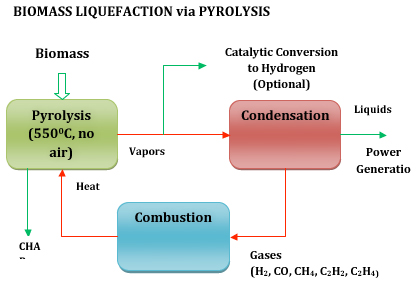The growing concerns about climate change have brought biochar, a charcoal produced from biomass combustion, into limelight.
Biochar is a carbon-rich, fine-grained residue which can be produced either by ancient techniques (such as covering burning biomass with soil and allowing it to smolder) or state-of-the-art modern pyrolysis processes. Combustion and decomposition of woody biomass and agricultural residues results in the emission of a large amount of carbon dioxide. Biochar can store this CO2 in the soil leading to reduction in GHGs emission and enhancement of soil fertility. Biochar holds the promise to tackle chronic human development issues like hunger and food insecurity, low agricultural productivity and soil depletion, deforestation and biodiversity loss, energy poverty, air pollution and climate change. Thus, biochar could make a difference in the energy-starved countries of Asia, Africa and Latin America as well as the industrialized world with its vast array of benefits. In addition to its potential for carbon sequestration, biochar has several other advantages.
- Biochar can increase the available nutrients for plant growth, water retention and reduce the amount of fertilizer by preventing the leaching of nutrients out of the soil.
- Biochar reduces methane and nitrous oxide emissions from soil, thus further reducing GHGs emissions.
- Biochar can be utilized in many applications as a replacement for other biomass energy systems.
- Biochar can be used as a soil amendment to increase plant growth yield.
Carbon Sequestration and Biochar
Biochar sequestration is considered carbon negative as it results in a net decrease in atmospheric carbon dioxide over centuries or millennia time scales. Instead of allowing the organic matter to decompose and emit CO2, pyrolysis can be used to sequester the carbon and remove circulating CO2 from the atmosphere and store it in virtually permanent soil carbon pools, making it a carbon-negative process. According to Johannes Lehmann of Cornell University, biochar sequestration could make a big difference in the fossil fuel emissions worldwide and act as a major player in the global carbon market with its robust, clean and simple production technology. The use of pyrolysis also provides an opportunity for the processing of agricultural residues, wood wastes and municipal solid waste into useful clean energy. Although some organic matter is necessary for agricultural soil to maintain its productivity, much of the agricultural waste can be turned directly into biochar, bio-oil, and syngas. Pyrolysis transforms organic material such as agricultural residues and wood chips into three main components: syngas, bio-oil and biochar (which contain about 60 per cent of the carbon contained in the biomass.
Production of Biochar
The two main methods for biochar production are fast pyrolysis and slow pyrolysis. The biochar yield is more than 50% in slow pyrolysis but it takes hours to complete. On the other hand, fast pyrolysis yields 20% biochar and takes seconds for complete pyrolysis. In addition, fast pyrolysis gives 60% bio-oil and 20% syngas.

|
The essential features of a fast pyrolysis process are:
- Very high heating and heat transfer rates, which often require a finely ground biomass feed
- Carefully controlled reaction temperature of around 500oC in the vapour phase and residence time of pyrolysis vapours in the reactor less than 1 s
- Quenching (rapid cooling) of the pyrolysis vapours to give the bio-oil product.
Importance of Bio-Oil
Bio-oil is a dark brown liquid and has a similar composition to biomass. It is composed of a complex mixture of oxygenated hydrocarbons with an Bio-oil has a much higher density than woody materials (three to six times, depending on form), which reduces storage and transport costs. Bio-oil is not suitable for direct use in standard internal combustion engines.
Alternatively, the oil can be upgraded to either a special engine fuel or through gasification processes to a syngas and then bio-diesel. Bio-oil is particularly attractive for co-firing because it can be more readily handled and burned than solid fuel and is cheaper to transport and store. Since the oil has a density of about 1200 kg per cubic meter, it can be conveniently transported over long distances. Current end-use possibilities are as a boiler fuel for stand-alone heat or in combined heat and power (CHP) using the steam cycle after either diesel or gas turbine electricity generation. The majority of these options have been found to be technically feasible. In addition, bio-oil is also a vital source for a wide range of organic compounds and specialty chemicals.







